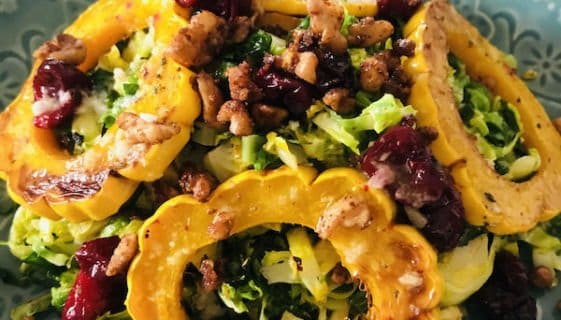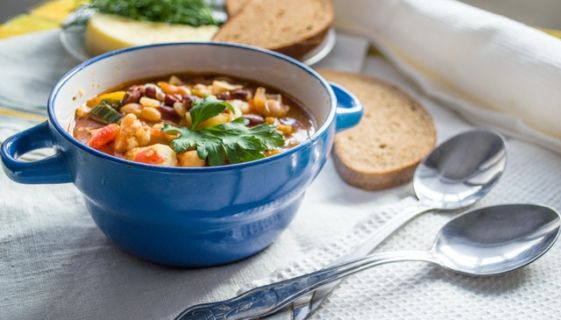If you are looking for a nutritious, hearty, and delicious meal, then look no further! This veggie-packed and easy-to-make dish is prepared with no-boil pasta and finished with a nutty cheesy topping. It is sure to satisfy vegetarians and meat lovers alike!
This lasagna can also be made vegan or gluten-free, utilizing the recommended substitutions. One serving of lasagna will please your taste buds as well as provide an abundance of plant-based protein, gut-boosting fiber, and immune-supporting antioxidants. The Bolognese sauce can also be used in multiple applications (topping pasta, salad, or rice, stuffing cabbage, sweet potatoes, or mushrooms, or as filling for a healthful sloppy joe’s or Shepherd’s pie). This comforting dish is a great dinner option everyone is guaranteed to enjoy.
Ingredients
Serves: 6
Lentil Bolognese
- 3 cloves garlic, minced 10-15 minutes before use and leave on cutting board to develop the maximum amount of allicin (health-supporting property)
- 2 tablespoons oil (olive, avocado, or sunflower)
- 1 medium yellow onion, minced
- 2 small or 1 medium carrot, diced
- 2 cups mushrooms, diced
- 1 zucchini, diced
- ½ teaspoon red pepper flakes (optional)
- 1 tablespoon Italian seasoning
- 2 bay leaves
- ½ cup green lentils (French green lentils work best)
- ¼ cup vinegar (red wine or white wine vinegar works best)
- 4 cups tomato sauce (no sugar added), divided into 3 cups and 1 cup
- 3/4 cup water or vegetable stock
- 3 handfuls spinach
- 1 bunch of fresh basil chopped or 2 tablespoons dried basil
- Salt and pepper to taste
Lasagna Layers
- 9 sheets of no-boil lasagna noodles (gluten-free or regular)
- 1 cup shredded mozzarella or vegan mozzarella (optional)
Topping
- ½ cup shredded parmesan or vegan parmesan*
-
- * pulse in a food processor until cheese texture: ½ cup walnuts or almonds, 3 Tbsp nutrition yeast, ½ tsp salt, ¼ tsp garlic powder
Directions
-
- Heat oil over medium heat in a large pot that has a lid. Add onion, carrot, mushrooms and zucchini and sauté for 5 minutes until onions are translucent. Add in red pepper flakes and Italian seasoning and continue to sauté for 2 more minutes until fragrant.
- Add the lentils, garlic, bay lead, and vinegar, stirring to combine with vegetables. Cook for 2-3 minutes to reduce vinegar by half.
- Stir in 3 cups tomato sauce, stock or water, and basil. Bring to a boil and reduce heat to low to simmer for 30 minutes covered with a lid.
- Remove lid and bay leaf, stir in spinach to wilt, taste, and season with salt and pepper.
Building the Lasagna
- Preheat oven to 400 degrees F.
- Using a 9×13 baking pan, spread a thin layer of olive oil and ½ cup of tomato sauce on the bottom of the pan. Place 3 sheets of lasagna noodles on top of a thin layer of sauce. Top then with 1/2 of Bolognese sauce then 1/3 cup of cheese. Repeat with 3 sheets of pasta, remaining bolognese, 1/3 cup of cheese, then 3 sheets of pasta, ½ cup of tomato sauce, and 1/3 cup of cheese.
- Bake in the oven for 15 minutes, then sprinkle with topping and cook for another 15 minutes. Remove from the oven and allow to sit for 5-10 minutes before cutting and serving.
Lasagna will keep fresh for 4-5 days, stored in an airtight container in the refrigerator. It will keep in the freezer for up to 6 months in freezer safe container. Thaw in the refrigerator overnight before reheating. It’s easy to reheat by placing it in a 400-degree F oven for 20 minutes.
Nutrition
Lentils: Good source of plant protein and folate. Areas around the world that have been identified to live the longest (Blue Zones) through research beans have been shown to be a common staple of consumption. Excellent source of dietary fiber that promote gut health (prebiotic), gut bacteria love beans.
Mushrooms: Make sure to cook your mushrooms to increase digestibility, degrade a possible toxic compound found in raw mushrooms and release nutrients that are stored in their thick cellular walls. Mushrooms are a very good source of dietary fiber (beta glucan), and one of the only foods that can store vitamin D when exposed to the sun. They contain anti-inflammatory properties and are rich in minerals such as selenium (an antioxidant). Their high potassium content can balance out sodium in the body.
Tomato Sauce: A great source of lycopene that helps reduce the risk of cancer and heart disease and protects skin integrity. Cooking tomatoes in a healthy fat (such as olive or avocado oil) increases the amount of available lycopene that the body will absorb.
Zucchini: Nutrient-dense vegetable packed full of fiber and water that aids in digestive health. The insoluble fiber helps us stay regular and the soluble fiber is a “prebiotic” food for the good bacteria to promote a healthy gut. This vegetable’s high amount of zeaxanthin (a powerful antioxidant) also plays a role in preventing oxidative stress to reduce the risk of developing cancer.
Spinach: Greens such as kale, spinach, collards, mustard greens, arugula, and chard have been shown to protect bones from osteoporosis, reduce inflammation, support a healthy gut, strengthen the immune system, protect cognition, and supply high amounts of antioxidants. They are among some of the best cancer-preventing foods.
Basil: Contains a range of protective vitamins such as Vitamins A, C, and K, as well as essential oils with high antioxidant properties due to the phytochemicals that help reduce oxidative stress in the body. These phytochemicals are known to reduce the risk of cancer, but also prevent age-related macular degeneration, and support liver and cardiovascular health. A unique component of basil is its ability to enhance and preserve the healthful properties of other ingredients it is combined with.
Garlic & Onions: Considered a prebiotic, meaning it feeds the “good” bacteria in our gut and promotes a healthy digestive system. Research supports that the compounds in garlic and onions, such as allicin, have antioxidant, anti-inflammatory, antimicrobial, and cardioprotective properties. If you chop your garlic 10-15 minutes before using it will have the maximum amount of active allicin.



 Ananda Kaplan
Ananda Kaplan 

